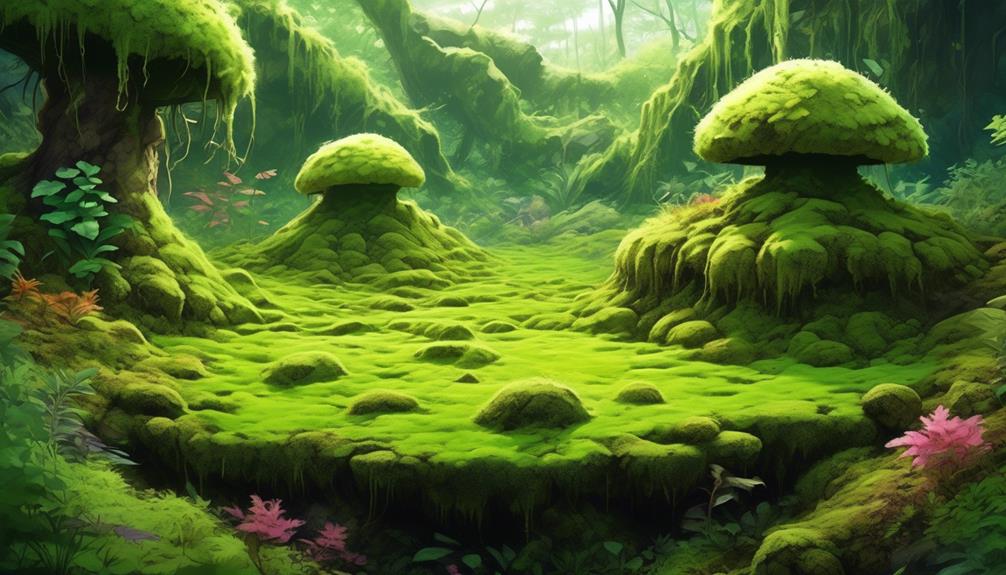You’re standing in your garden, surrounded by bags of moss, wondering which one to choose for your gardening needs.
As you glance at the options, you notice two types: sphagnum moss and peat moss. They both seem similar, but what’s the difference?
Well, my friend, get ready to uncover the distinctions between these two mosses and discover which one will work best for your gardening endeavors.
Sphagnum Moss Vs Peat Moss…
- Sphagnum moss is pure moss without any other plant material and has a neutral pH, while peat moss consists of a mixture of organic materials and is more acidic.
- Both mosses improve water retention and soil structure, but peat moss can absorb slightly more water than sphagnum moss.
- Peat moss is primarily used as a soil amendment for acid-loving plants, while sphagnum moss is used for seed-starting, lining baskets, growing orchids, and as an additional growing material in potting soils.
- Peat moss extraction has a more detrimental environmental impact, causing damage to habitats and endangering rare species, while sphagnum moss is harvested without causing harm to the environment.
Composition Differences
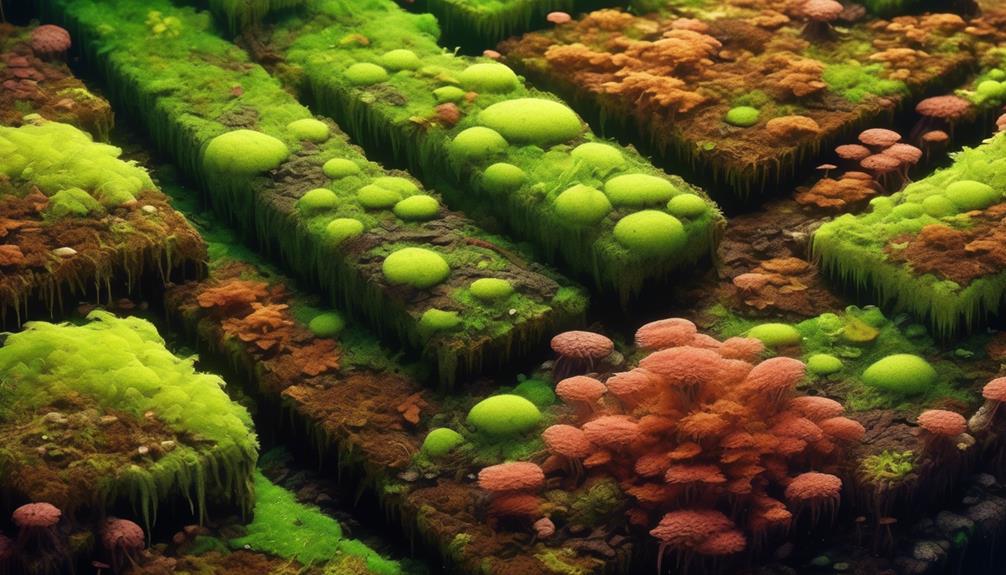
The composition of sphagnum moss and peat moss differs significantly, with sphagnum moss being pure moss without any other plant material, while peat moss consists of a mixture of organic materials, including moss, decaying plant matter, and dead insects.
This distinction in composition has important implications for gardening.
Sphagnum moss, being pure moss, is rich in organic matter and has a neutral pH.
It’s often used as a seed-starter, for lining baskets, growing orchids, and as an additional growing material in potting soils.
On the other hand, peat moss, with its mixture of organic materials, is primarily used as a soil amendment to improve water retention and density, especially for acid-loving plants.
It’s important to note that sphagnum peat moss, unlike sphagnum moss, is acidic and high in tannins. This acidity can affect the pH of the soil, making it more suitable for acid-loving plants.
Additionally, the organic matter in peat moss helps improve the soil structure by increasing its ability to retain water. By understanding the composition differences between sphagnum moss and peat moss, gardeners can make informed decisions on which material to use based on the specific needs of their plants.
Water Retention Variances
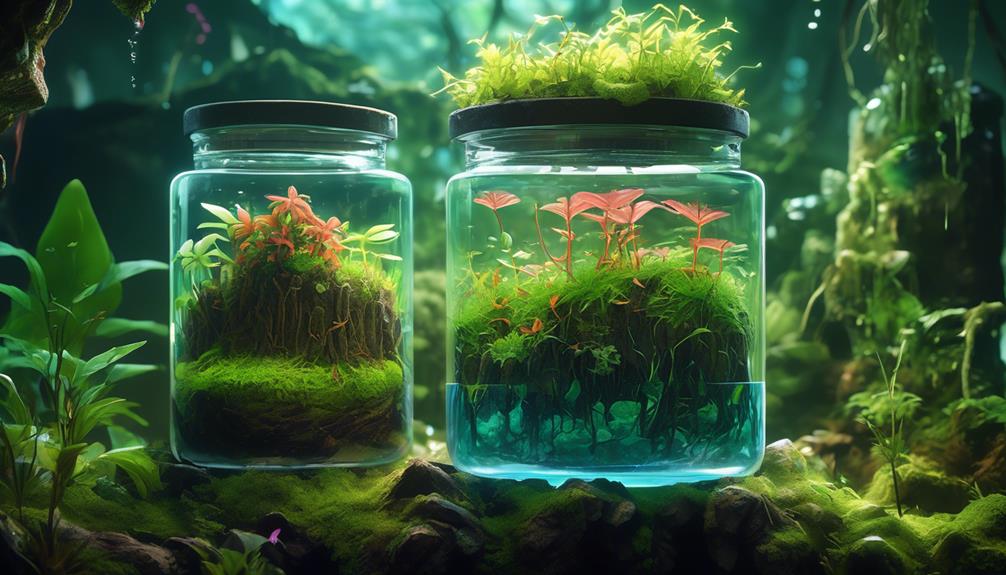
When considering the differences in water retention between sphagnum moss and peat moss, it’s important to note that both materials have the ability to improve water retention in soils, making them effective for various soil types.
Peat moss, known for its exceptional water-holding capacity, can absorb up to 20 times its weight in water. On the other hand, sphagnum moss, renowned for its moisture-retaining properties, can absorb between 16 and 26 times its weight in water. Both mosses excel at holding water due to their fibrous nature and ability to retain organic material.
For gardeners looking to enhance water retention in their soil, sphagnum moss and peat moss are excellent choices. In acidic soils, such as those found in sphagnum bogs, both mosses provide an ideal environment for plant growth.
Peat moss, with its slightly acidic pH, can help neutralize alkaline soils, while sphagnum moss can be beneficial for maintaining a neutral pH. These organic materials not only increase water retention but also enhance soil structure, allowing for better nutrient absorption by plants.
Whether you’re growing in clay, chalk, or sandy soils, both sphagnum moss and peat moss offer significant benefits for water retention. Their ability to hold water makes them valuable additions to any gardening endeavor, ensuring that your plants receive adequate moisture even in dry periods.
Decomposition Rates
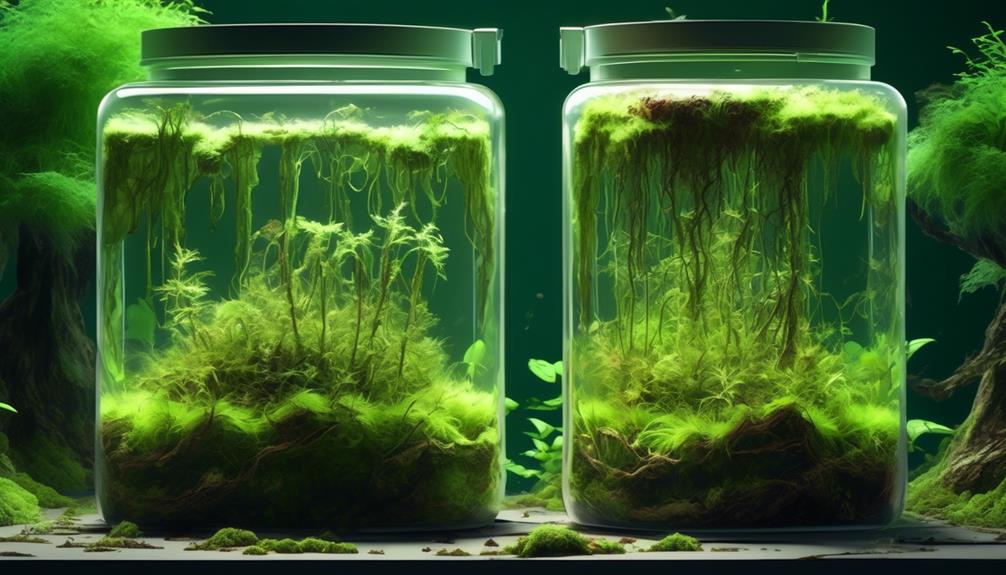
To understand the differences in decomposition rates between sphagnum moss and peat moss, it is important to recognize that sphagnum moss decomposes at a faster rate compared to peat moss due to its living nature and the harvesting process it undergoes.
Sphagnum moss, being a living plant, has a higher decomposition rate compared to peat moss, which consists of dead and decayed plant matter. Peat moss is made up of dead, compacted, but not decomposed plants, resulting in a slower decomposition rate.
This difference in decomposition rates can be attributed to the fact that sphagnum moss is harvested while alive and then dried for commercial use. On the other hand, peat moss is harvested from peat bogs as dead and decayed plant material.
To further understand the contrast in decomposition rates:
| Sphagnum Moss | Peat Moss | |
|---|---|---|
| Nature | Living plant | Dead and decayed plant matter |
| Harvesting Process | Harvested while alive and dried | Harvested from peat bogs as dead material |
| Decomposition Rate | Faster | Slower |
As we can see, sphagnum moss has a faster decomposition rate compared to peat moss. This difference is primarily due to the living nature of sphagnum moss and the harvesting process it undergoes. It is important to consider these decomposition rates when using moss for gardening purposes, as they can impact the overall health and longevity of the garden.
“Did you know? Sphagnum moss has been used for centuries as a natural wound dressing due to its antimicrobial properties. It was commonly used during World War I to treat soldiers’ wounds.”
Ph Levels and Soil Correction
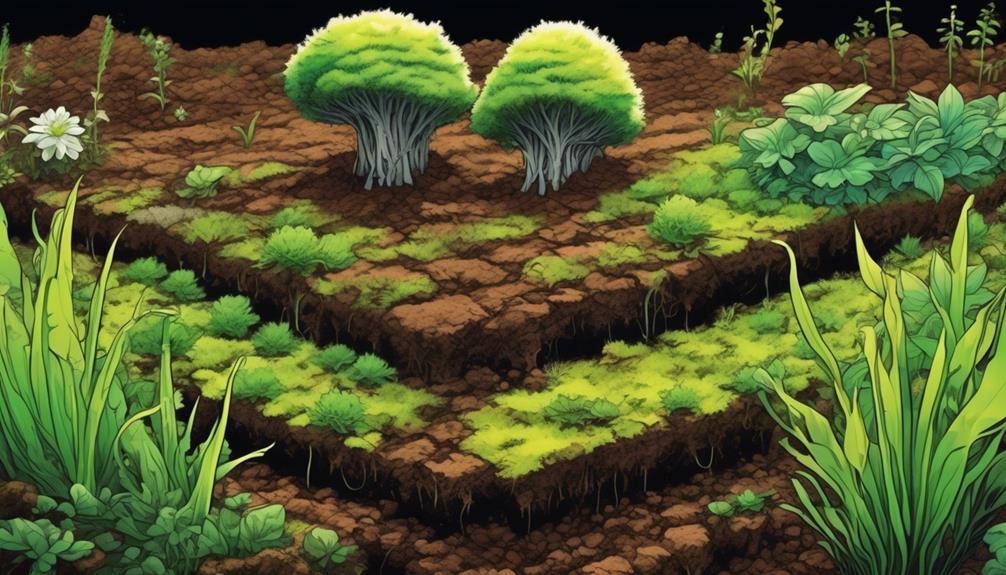
Adjusting the pH levels of soil for optimal plant growth can be achieved through the use of sphagnum or peat moss as soil amendments.
Sphagnum moss has a neutral pH level, making it suitable for a wide range of plants. However, it’s important to note that peat moss is more acidic compared to sphagnum moss due to the presence of tannins. This makes peat moss a great choice for acid-loving plants or highly alkaline areas where the soil needs to be corrected.
The pH level of soil is crucial for plant growth as it affects nutrient availability.
Some plants prefer acidic soil, while others thrive in alkaline conditions. By incorporating sphagnum or peat moss into the soil, you can adjust the pH levels to meet the specific needs of different plants. Peat moss work by slowly releasing organic acids into the soil, lowering the pH levels and making the soil more acidic if needed.
In addition to pH level adjustment, sphagnum and peat moss also offer other benefits for gardening. They have excellent water retention properties, keeping the soil moist for longer periods. This can be particularly helpful in dry climates or for plants that require consistent moisture. Furthermore, sphagnum and peat moss improve soil aeration and drainage, promoting root development and preventing waterlogging.
Environmental Impact
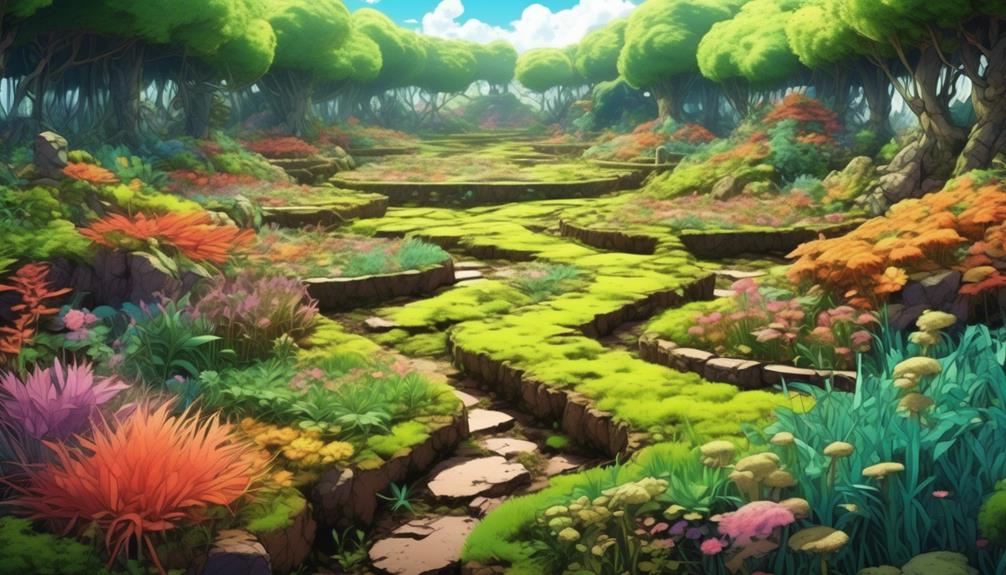
Both sphagnum moss and peat moss have significant environmental impacts, but peat moss extraction is considered to be more detrimental due to its deeper digging and slower formation.
Peat moss is harvested from bogs, which are unique and fragile ecosystems. The process involves draining the bog and removing the top layer of vegetation to access the peat deposits. This extraction method can cause irreparable damage to the surrounding habitat, potentially destroying habitats for rare and endangered species.
To further understand the environmental impact of sphagnum moss and peat moss:
| Characteristic | Sphagnum Moss | Peat Moss |
|---|---|---|
| Formation | Grows rapidly | Forms slowly |
| Extraction | Harvested without causing damage to the environment | Harmful to the environment, destroys habitats |
| pH Levels | Neutral | Acidic |
| Water Retention | High | High |
| Soil Amendment | Improves soil structure and fertility | Improves soil structure and fertility |
As you can see, both sphagnum moss and peat moss have environmental impacts but peat moss is a lot more damaging to the environmental simply due to its extraction process. This has led many gardeners to seek sustainable alternatives for using peat moss when gardening.
By choosing alternative growing mediums, you can reduce your environmental impact and support sustainability. It is important to consider the long-term consequences of our gardening practices and prioritize the preservation of our natural ecosystems.
Using Sphagnum Moss In The Garden
Sphagnum moss is a versatile material that can be used in various ways in gardening. Here are several different ways people use sphagnum moss in their gardens:
- Potting Mix Amendment: Sphagnum moss is often added to potting mixes to improve water retention and aeration. It helps retain moisture around the plant roots and prevents soil from drying out too quickly. Mix sphagnum moss with other components like compost, perlite, and vermiculite to create a well-balanced potting mix.
- Seed Starting Medium: Sphagnum moss can be used as a seed starting medium due to its ability to hold moisture and provide a sterile environment. It helps maintain consistent moisture levels, promoting germination and healthy seedling growth. You can create a seed-starting mix by blending sphagnum moss with vermiculite or perlite.
- Hanging Basket Liner: When lining hanging baskets or containers, sphagnum moss acts as a natural liner that helps retain moisture and prevents soil from escaping. Simply line the basket or container with a thick layer of moist sphagnum moss before adding the potting mix and plants. This method also enhances the appearance of the hanging basket.
- Transplanting Aid: Sphagnum moss can be used during transplanting to protect delicate plant roots from damage and aid in their recovery. Wrap the root ball of the plant with moist sphagnum moss before planting it in its new location. The moss helps retain moisture, reduces transplant shock, and encourages root development.
- Terrarium Ingredient: Sphagnum moss is commonly used in terrariums to create a humid microclimate for plants that require higher moisture levels. It acts as a natural sponge, absorbing and slowly releasing moisture into the environment, maintaining optimal humidity for plants.
Remember to keep sphagnum moss moist but not waterlogged, as excessive moisture can lead to fungal diseases. Additionally, choose sustainably harvested sphagnum moss or consider alternatives like coconut coir if environmental concerns arise.
Using Peat Moss In The Garden
Peat moss is a versatile material that can be used in various ways to improve the quality of your garden soil and enhance plant growth. Here are several different ways you can use peat moss in your gardening:
- Soil amendment: Peat moss is an excellent soil amendment that helps improve soil structure and texture. It lightens heavy clay soils, allowing better drainage, and increases water retention in sandy soils. Mix peat moss with your existing soil to improve its quality and create a more suitable environment for plant growth.
- Seed starting: Peat moss is commonly used as a component in seed starting mixes. Its fine texture provides a loose and well-aerated medium for seeds to germinate and establish strong root systems. Mix peat moss with perlite or vermiculite to create a lightweight and well-draining seed starting mix.
- Potting mix ingredient: Peat moss is a popular ingredient in homemade or commercial potting mixes. Its ability to retain moisture while providing good drainage is ideal for container gardening. Mix peat moss with compost, perlite, and other amendments to create a well-balanced potting mix for potted plants.
- Soil conditioner: Peat moss can be used as a soil conditioner to improve the overall health of your garden soil. It helps to acidify alkaline soils and increase the organic matter content, which promotes beneficial microbial activity and nutrient availability. Apply a layer of peat moss on the soil surface and gently work it into the top few inches of soil.
- Mulching: Peat moss can be used as a mulch to conserve moisture, suppress weeds, and regulate soil temperature. Apply a layer of peat moss around the base of plants, being careful not to pile it against the stems or trunks. It will gradually break down and enrich the soil with organic matter.
- Acid-loving plants: Peat moss is particularly beneficial for acid-loving plants such as azaleas, rhododendrons, and blueberries. These plants thrive in acidic soil conditions, and incorporating peat moss into the planting hole or mixing it with the existing soil helps create the ideal pH level for their growth.
It’s important to note that peat moss is a non-renewable resource, and there are concerns about its sustainability. Consider using alternative organic materials such as compost, coconut coir, or well-rotted manure if you prefer more sustainable gardening practices.
Sphagnum Moss or Peat?
The differences between sphagnum moss and peat moss for gardening are truly remarkable. Sphagnum moss, with its pure, alive and dried composition, is a versatile option for seed-starting and growing orchids.
On the other hand, peat moss, being the decayed plant matter of sphagnum moss, is an excellent soil amendment preferred by acid-loving plants. However keep in mind the environmental impacts.
With varying water retention, decomposition rates, and pH levels, these mosses provide unique benefits to gardeners. Their environmental impact also highlights the importance of making informed choices for sustainable gardening practices.
